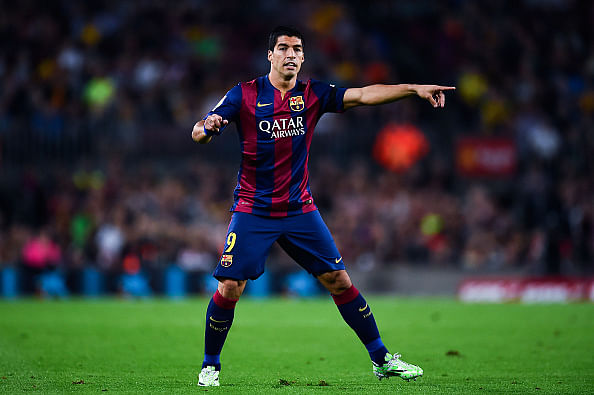
Why Luis Suarez's role at Barcelona needs to change
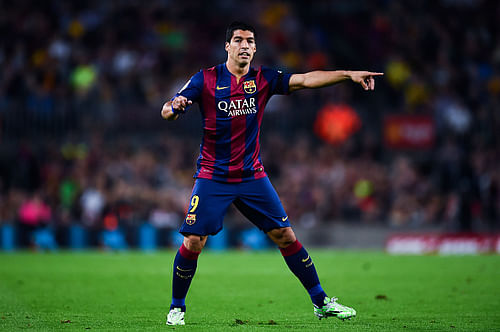
"I'm sure Suarez should end up playing as a No 9 with Lionel Messi just behind him as playmaker." – Fabio Capello
By stating the above, Fabio Capello joined the long queue of critics who have suggested numerous changes in how Barcelona must line up. After back-to-back defeats in La Liga, all is not well at the Camp Nou as Barca have not only surrendered the top spot to their arch rivals but have dropped down to fourth behind Atletico Madrid and Valencia.
Manager Luis Enrique has been under fire ever since their defeat at PSG. And with the look of things, it doesn’t seem like Enrique will be shouting “Eureka” and scampering out of Camp Nou in ecstasy anytime soon. After an eventful transfer window in the summer with Luis Suarez being the icing on the cake, it was no exaggeration to call Barcelona a fierce contender for the UEFA Champions League.
There are quite a few who still believe it isn’t, but it looks like the fingers of reality point towards a different direction of things in store this season.
Why is a change necessary?
Misfiring Uruguayan
The game against Celta Vigo at Camp Nou was a stage tailor-made for Suarez to add his name into the legendary list of players who had scored on their first appearance at the Camp Nou; like Johan Cruyff, Rivaldo, Ronaldinho and Romario did. Enrique tried to fit in the Uruguayan on the right with Messi at the centre and Neymar on the left. The trio broke open the defence on numerous occasions, but the finishing wasn’t clinical enough.
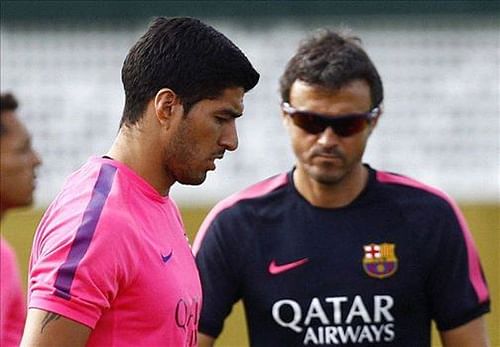
As the game progressed, Celta grew into it nicely and looked much more settled. And after the first goal was netted by the visitors, the Catalans pressed the panic button as an immediate reaction. The attacking third became chaotic with Suarez cutting into the centre which in turn cramped Messi for space in the middle.
Barca had thereby lost their shape trying to alter Suarez’s position during the course of the game. It resulted in nothing more than an unorganized attack with wasteful passing and thus both Barcelona and Messi recorded their worst pass accuracy in the Liga this season with 81% and 70% respectively.
The average players’ position map shows how Messi and Suarez were cramped for space in the middle. The positioning of the two wasn’t precise, especially after Suarez began to move freely away from the right towards the centre during the second half.
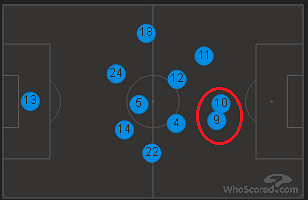
To begin with, we all know why Luis Suarez has been brought in at the Camp Nou as Barca have been in need of a goal-poacher as an alternative to Messi. His arrival for a lump-sum despite the four-month ban shows the sheer quality that the player instils into the attack.
And ever since the demise of the Henry-Eto’o-Messi combination, the front-three of Barca haven’t been quite as fiery yet. However, it is appreciable that they have woken up and realized the need to add a pure no.9 to their attack. But it is also high-time they realize that the purpose of the Uruguayan would be defeated in the event that he is deployed as second fiddle.
There were a number of occasions in the previous season wherein he was deployed as a wide forward/winger by Brendan Rodgers to keep intact the in-form Daniel Sturridge at the centre. The situations wherein the Uruguayan started out wide with Sturridge at the centre yielded both positive and negative results for Liverpool as a whole, but the impact on Suarez’s performance remained unchanged in all of those games.
|
POSITION |
STRIKER |
WINGER |
|---|---|---|
|
GAMES |
28 |
5 |
|
GOALS |
30 |
1 |
|
CHANCES CREATED |
76 |
11 |
|
PASS ACCURACY % |
83% |
72% |
|
SHOT ACCURACY % |
55% |
39% |
The stats have been taken from those games in which Suarez had played the game throughout on the left/right wing and they clearly indicate where Suarez must play to be unleashed as the deadly player he is. Another important factor that Enrique needs to ponder is the kind of build-up play in the attacking third that he has instilled into Barca.
Of late, much of the attacks for the Catalans has been from the flanks with a great deal of crosses into the box. Brazilian right-back Dani being the major source of these crosses, averaging about 10 crosses per game. But in truth, they often go wasteful as they fail to pick out the no.9 in the box.
This is an area where the Uruguayan excels as his positioning is simply exceptional and a real poacher when it comes to dealing with crosses. To put it in numbers, out of 31 goals netted by Luis Suarez, 6 of them were from aerial balls dipping into the box from the flanks. This might not seem as astounding, but the fact is even the Argentine could not manage to net in crosses at a similar ratio last season.
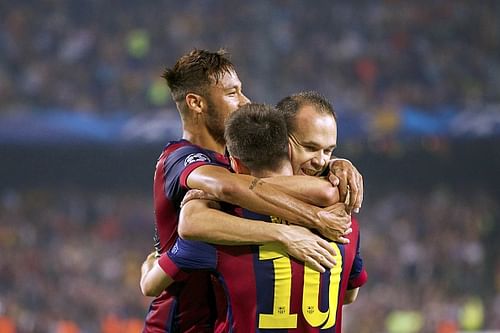
The rise of Lionel Messi the playmaker
Another major reason has been the revelation of Messi’s role in Enrique’s Barcelona. The Argentine has been dropped further to central midfield from his typical false 9 position. The onus to dictate play in the final third has heavily been on the little maestro. It is no secret that Messi is no more the finisher he was a couple of seasons ago. But at the same time, the influence he has on the game remains unchanged.
It is surprising to see a list of top goalscorers which doesn’t feature Messi even in the top three. But on the other hand, the four-time Ballon d’Or winner has been the mastermind who has unleashed Neymar this season. Messi tops the assists table with 7 to his tally and also leads the list of players with most key passes in La Liga with 3.3 per game.
|
SEASON |
2014/15 |
2013/14 |
|---|---|---|
|
Goals scored |
0.70 |
0.90 |
|
Total shots |
4.70 |
5.16 |
|
Shot accuracy % |
62% |
67% |
|
Chances created |
3.30 |
2.42 |
|
Assists |
0.70 |
0.35 |
|
Key passes |
2.60 |
2.06 |
Successful managers are those who have the vision to see a player’s evolution and accordingly alter his role to suit the team. Pep Guardiola is an example as he moved Messi from the right to a false 9 – something that turned out to be the most successful decision in Guardiola’s managerial career. In this case, Messi doing justice to the number on his back has come at a near perfect time for Barcelona. Such a no.10 might be all that the Uruguayan needs when he occupies the central position on the attack.
How to bring about the change?
4-3-3 with Messi on the wing
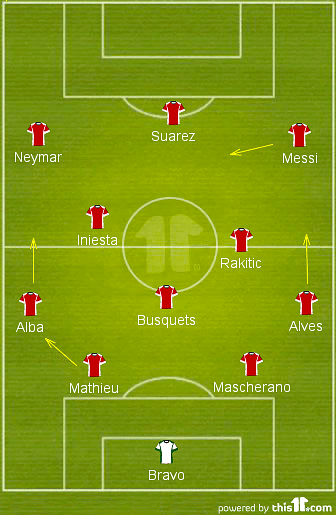
The core-concept behind this formation is stretching the opposition’s back four using the width provided by Neymar and Messi on the left and right respectively. It creates gaps between the defenders to be utilized by the no.9. Messi starts out wide on the right in this formation. By marking him with more than one defender, the opposition run the risk of leaving gaps in central areas which are likely to be exploited by the likes of Suarez and Iniesta.
Deploying Messi on the right also keeps the opponent’s left-back in check and often refrains from joining the attack with the danger of leaving Messi in space always loitering in his mind.
4-2-3-1 with Messi as playmaker
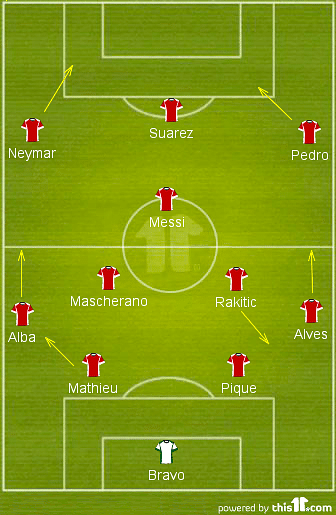
This is a formation which has never been a part of Barcelona’s dictionary and it is also true that it is not likely to happen anytime soon. However, this formation focuses on utilizing Messi as a typical no.10 having three attackers ahead of him. A 4-2-3-1 with Neymar, Suarez and Pedro up front is likely to be very effective against the smaller oppositions in the Liga who often make it difficult to break through their defence.
The Catalans are often frustrated by quite a few teams in the Liga who defend with their lives for ninety minutes and celebrate in joy even if they grab a point. This can really work wonders in such situations and we could even notice hints of this formation against Celta when Pedro was brought on as a substitute.
4-3-1-2 diamond
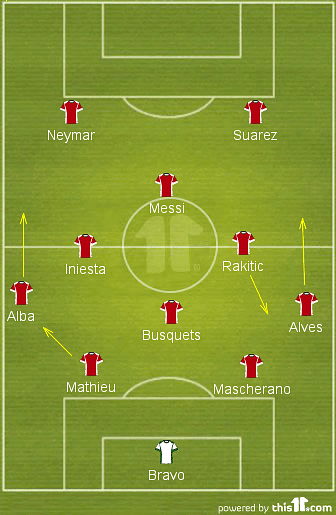
This is similar to the 4-3-3 formation with Messi at the centre; the only difference being Messi staying deeper at a no.10 role and the narrow positioning of the front two to form a classic 4-4-2. This is the most likely formation that Enrique might try as Messi will be in a central position with Suarez up front as a no.9. Offering width on the attack could be a problem with a 4-4-2 and that remains a task which must be taken care of by the fullbacks.
In the event of facing a side like Real Madrid who have quick wingers, the diamond could be stretched due to the lack of width and there needs to be a strong willingness for the players to track back on the counter or risk leaving defence vulnerable.
Conclusion
It has become absolutely evident that the Catalans are due for tactical and formational changes. However, the formation of the team is based on the kind of players a manager has and it is never the other way round. It is a fact that Enrique has to keep in mind before trying out the combinations he thinks would set the team right.
Moreover, the sooner he unleashes Suarez the better it is for the Blaugranas who are hoping to avoid another trophy-less season, especially after a lavish spending spree in the summer. Will Luis Suarez add a bite to the Catalan attack?
You could say, “Luis’ fate depends largely on Luis”. Hold on, you can put Suarez first and Enrique at the end or vice versa, it is going to hold true either ways.